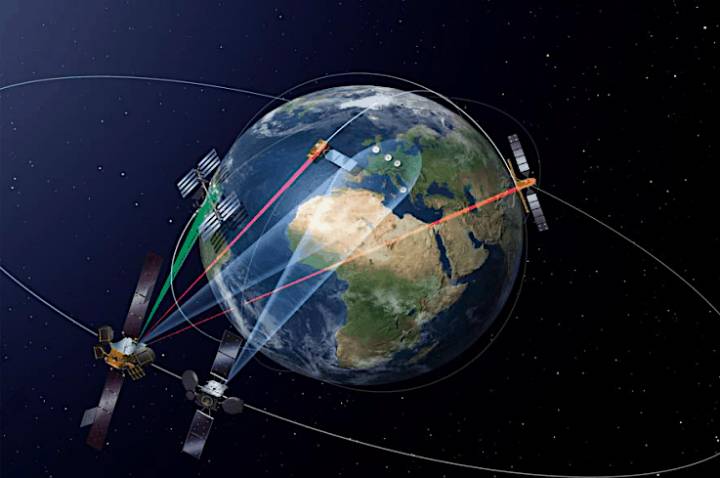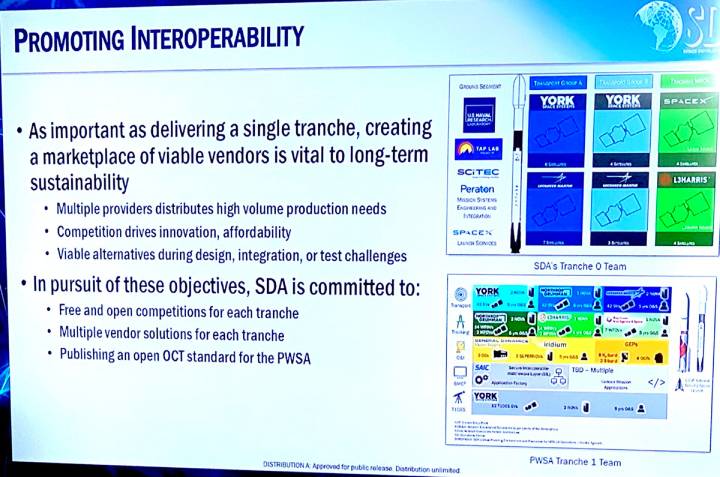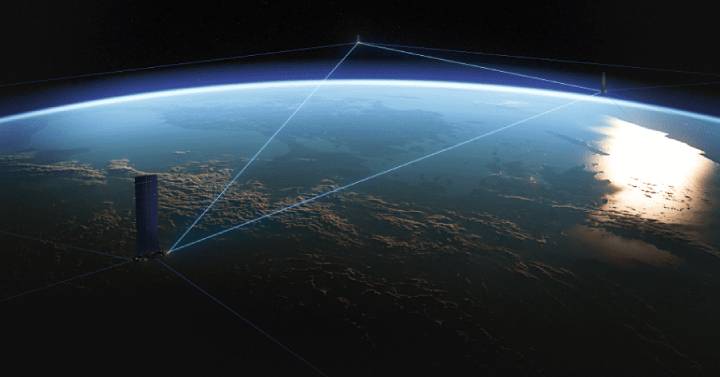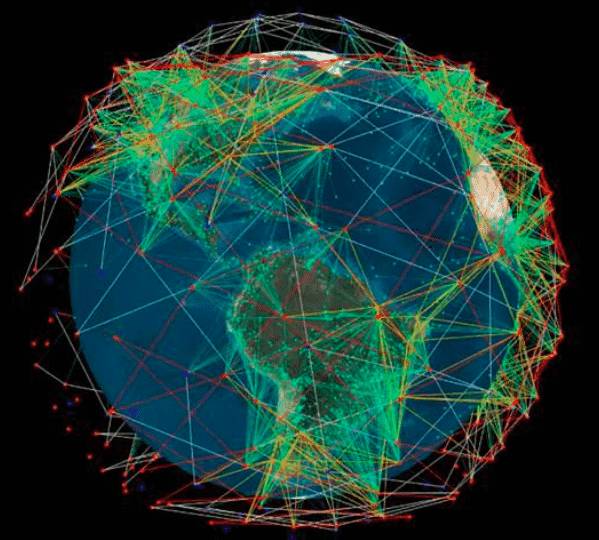 Industry officials expect laser communications terminals one day to be on most non-geostationary-orbit Earth observation and communications satellites. But qualifying the technology in orbit is taking longer than expected. (Source: Tesat Spacecom)
Industry officials expect laser communications terminals one day to be on most non-geostationary-orbit Earth observation and communications satellites. But qualifying the technology in orbit is taking longer than expected. (Source: Tesat Spacecom)
KUALA LUMPUR, Malaysia — Any company designing a data-relay or broadband satellite constellation would prefer to hold off selecting its laser communications terminal (LCT) supplier until the U.S. Space Development Agency (SDA) has performed in-orbit validation of at least two, if not all four, of the LCT providers it’s working with.
“We know the technology works and we know the engineering, but that’s on GEO satellites at a cost of 10s of millions for the [LCT] nodes — not sufficient for a commercial, proliferated product,” said Rizwan Parvez, senior director of business development at Maxar Technologies and a former chief technology officer at BridgeComm, created to commercialize optical links for space and airborne applications.
“We have organizations looking to build their businesses off the success of this core technology. We are waiting to see how they’ve done” with SDA, Parvez said here Oct .12 at the APSCC 2023 conference.
 Interoperability from multiple contractors is an SDA priority. (Source: SDA)
Interoperability from multiple contractors is an SDA priority. (Source: SDA)
But not all these constellations have the luxury of being able to wait for an SDA verdict. For business or regulatory-compliance reasons, they need to make their choice before the SDA has confirmed that the relatively small, inexpensive LCTs it’s using are capable of performing gigabit-per-second transmissions and are interoperable with competitors’ LCTs.
Telesat, Rivada Space Networks, Kepler Communications, the European Commission and others have set deadlines coming up before the SDA has done its testing.
That became clear with the recent SDA announcement that it would not start in-orbit tests of the Tesat Spacecom terminals, on the Tranche 0 satellites launched in April and June, until December. SDA will begin launching other manufacturers’ LCTs in December, so initial interoperability testing cannot be done before perhaps next spring.
Constellation operators whose schedules are more urgent than will need to trust their own in-house expertise to assess the flight-worthiness of this new generation of LCTs, or rely on their selected prime contractors to make the choice.
 Catharine Parnell, counsel at Skyloom. (Source: Silicon Valley Space Week video)
Catharine Parnell, counsel at Skyloom. (Source: Silicon Valley Space Week video)
SDA has organized, with the U.S. Naval Research Lab, a facility to permit LCT manufacturers to test their hardware’s compatibility with competitors’ LCTs. Catharine Parnell, counsel at Skyloom, said the process appears to have been successful in accelerating the move toward interoperability.
“We at Skyloom salute the SDA for taking that initiative,” Parnell said Oct. 20 at the Silicon Valley Space Week conference in Mountain View, California.
“It’s a really interesting proposition to buy your competitors’ product and get it into a test lab to make sure it works with yours. It’s a unique perspective to have in building out a constellation. I think it’s going well,” Parnell said.
LCTs for LEO constellations are viewed as a key technology — for some, the most crucial — to assure quick and secure transfer of data without the need of a network of ground stations.
The technology’s progress has been unusual.
 (Source: SpaceX Starlink)
(Source: SpaceX Starlink)
The world’s biggest constellation operator, SpaceX Starlink, says it has fitted 2,900 of its satellites with SpaceX-developed LCTs but has not been clear about their performance. A recent presentation by the company focused on the space-to-ground laser links rather than the satellite-to-satellite cross links that are of at least equal importance: SpaceX Starlink: We’ve successfully deorbited 99% of our failed satellites; 2,900 Starlinks have laser communications - Space Intel Report
SpaceX’s LCT is not being put through the SDA’s interoperability tests and SpaceX has not offered to sell its terminals to other satellite operators.
 The Lightspeed constellation’s initial design has been reduced to 188 operational satellites from 298. (Source: Telesat)
The Lightspeed constellation’s initial design has been reduced to 188 operational satellites from 298. (Source: Telesat)
Before SpaceX began fielding LCTs in earnest, the biggest laser terminal deal was Telesat’s agreement to purchase Thales Alenia Space Switzerland terminals, which have never flown, for its multibillion-dollar Lightspeed constellation.
Telesat, a satellite fleet operator that prides itself on its technical competence, said it thoroughly vetted the Thales technology and did not make its choice simply because Thales Alenia Space had been selected as Lightspeed’s prime contractor.
Telesat earlier this year switched to MDA Corp. of Canada as Lightspeed prime contractor after MDA made a much less expensive proposal. Telesat insists the MDA design has the same performance as the one Thales Alenia Space was going to build. Each satellite will carry four laser terminals.
There has been no indication that MDA has made a choice of LCT provider. Thales Alenia Space Switzerland has made no move to create a U.S. subsidiary and take part in the SDA vetting. It’s as though the company, having won the biggest competitively bid LCT contract ever, has disappeared from the market.
Similarly, Rivada Space Networks, under tremendous pressure to field its 600-satellite constellation with prime contractor Terran Orbital, has not made a choice of LCT provider.
The European Commission, which has a self-imposed deadline of Q1 2024 to decide on contractors for its Iris2 multi-orbit network, is negotiating with a large consortium of hardware providers and has made no LCT choice.
Two of the four LCT providers working with the SDA, Tesat and Mynaric, are based in Europe and would be eligible for Iris2 work. The other two are SA Photonics/CACI and Skyloom.
 Wen Cheng Chong, chief strategy officer, Kepler Communications. (Source: Kepler)
Wen Cheng Chong, chief strategy officer, Kepler Communications. (Source: Kepler)
One company that is moving forward before the SDA results are known is Kepler Communications of Canada.
Kepler, which has raised over $200 million, is designing a constellation of satellites in low orbit that will offer LCT-enabled high-speed data-transfer to customers.
Kepler’s first two LCT-equipped satellites are scheduled for launch in November on the SpaceX Transporter-9 ride-share mission. Both carry Tesat LCTs.
Kepler has also selected Tesat to support its first orbital ring of 10 satellites.
Wen Cheng Chong, Kepler’s co-founder and chief strategy officer, told the Oct. 12 APSCC 2023 meeting that Kepler wants to use multiple LCT providers, “making sure we’re supporting interoperability between all terminals.”
“The simplest way to think about us is that we are a commercial version of SDA,” Wen said. “We want to democratize optical communications and internet in space. Customers need to be able to buy terminals from Mynaric, from Tesat, from anyone you can think of and they should all just work.”
“We are not exclusive to Tesat,” Wen said. “Whichever terminal wins out, we wil go for them. But we are pushing for interoperability between all terminals.”
Wen said Kepler chose Tesat not so much because it had been selected as the first to fly on the SDA satellites, but because Kepler vetted the Tesat LCT on its own.
“It’s more our own due diligence, evaluating the suppler and their technology,” Wen said. “We sent our engineers out to the [Tesat] factory and we are very confident.”
 Shane Fleming, vice president, global business development, Kepler Communications. (Source: Kepler)
Shane Fleming, vice president, global business development, Kepler Communications. (Source: Kepler)
Kepler’s constellation will require the LCTs to maintain stable, high-speed links at a range of 6,000 kilometers between satellites, said Shane Fleming, Kepler’s manger for global business development.
“We at Kepler try to be efficient with our capital when doing our architecture,” Fleming said Oct. 18 at the Silicon Valley Space Week conference. “Just continuing to fly spacecraft is very expensive. With our proliferated LEO architecture alone, and optical inter-satellite links, we’ve got link ranges of 6,000 kilometers. Inherently, we can cover all of low Earth orbit between 400 and 1,400 kilometers [in altitude] with just 20 spacecraft.”
Fleming said Kepler greatly appreciates the work SDA has done in creating LCT standards and insisting in interoperability among suppliers. “That has really helped bring as pool of suppliers. It’s brought competition and brought the courts of those terminals down,” he said.
